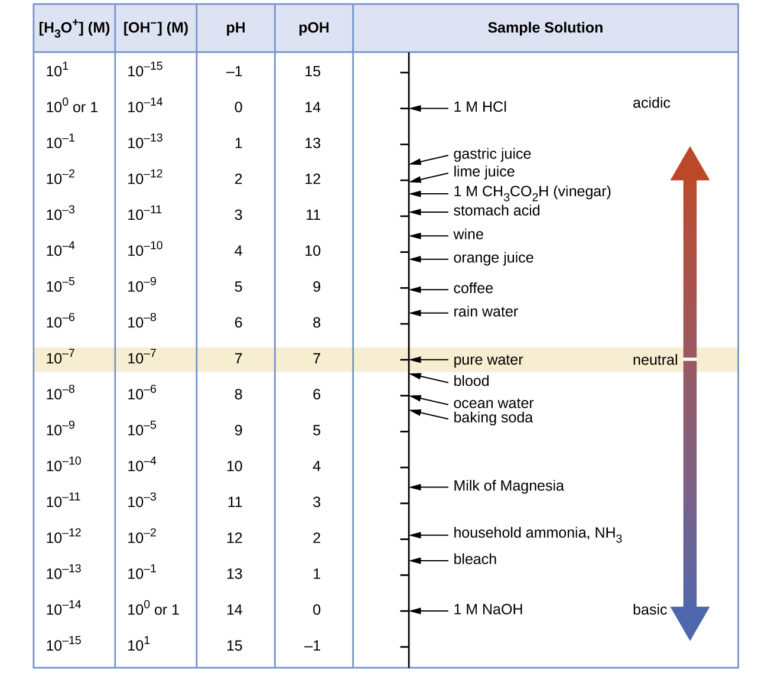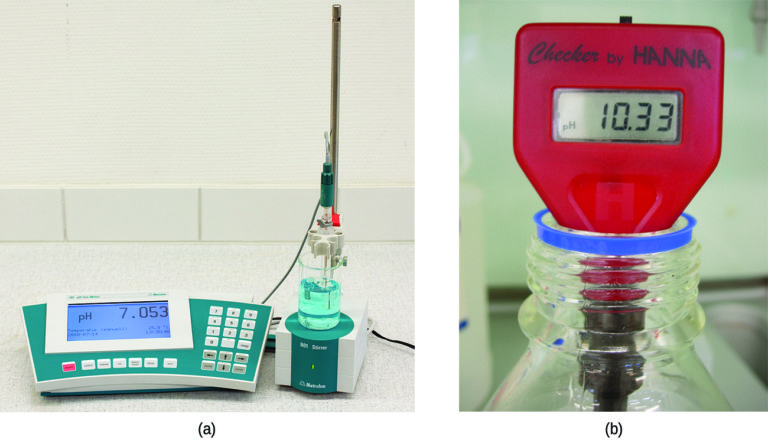7.2 pH and pOH
Learning Objectives
By the end of this section, you will be able to:
- Explain the characterization of aqueous solutions as acidic, basic, or neutral
- Express hydronium and hydroxide ion concentrations on the pH and pOH scales
- Perform calculations relating pH and pOH
As discussed earlier, hydronium and hydroxide ions are present both in pure water and in all aqueous solutions, and their concentrations are inversely proportional as determined by the ion product of water (Kw). The concentrations of these ions in a solution are often critical determinants of the solution’s properties and the chemical behaviors of its other solutes, and specific vocabulary has been developed to describe these concentrations in relative terms. A solution is neutral if it contains equal concentrations of hydronium and hydroxide ions; acidic if it contains a greater concentration of hydronium ions than hydroxide ions; and basic if it contains a lesser concentration of hydronium ions than hydroxide ions.
A common means of expressing quantities, the values of which may span many orders of magnitude, is to use a logarithmic scale. One such scale that is very popular for chemical concentrations and equilibrium constants is based on the p-function, defined as shown where “X” is the quantity of interest and “log” is the base-10 logarithm:
pX = -log X
The pH of a solution is therefore defined as shown here, where [H3O+] is the molar concentration of hydronium ion in the solution:
pH = -log [H3O+]
Rearranging this equation to isolate the hydronium ion molarity yields the equivalent expression:
[H3O+] = 10-pH
Likewise, the hydroxide ion molarity may be expressed as a p-function, or pOH:
[H3O+] = -log [OH–]
or
[OH–] = 10-pOH
Finally, the relation between these two ion concentration expressed as p-functions is easily derived from the Kw expression:
Kw = [H3O+] [OH–]
-log Kw = -log([H3O+] [OH–]) = -log [H3O+] + -log [OH–]
pKw = pH +pOH
At 25 °C, the value of Kw is 1.0 × 10−14, and so:
14.00 = pH +pOH
As was shown in the previous section, the hydronium ion molarity in pure water (or any neutral solution) is 1.0 × 10−7 M at 25 °C. The pH and pOH of a neutral solution at this temperature are therefore:
pH = -log [H3O+] = -log (1.0 × 10−7) = 7.00
pOH = -log [OH–] = -log (1.0 × 10−7) = 7.00
And so, at this temperature, acidic solutions are those with hydronium ion molarities greater than 1.0 × 10−7 M and hydroxide ion molarities less than 1.0 × 10−7 M (corresponding to pH values less than 7.00 and pOH values greater than 7.00). Basic solutions are those with hydronium ion molarities less than 1.0 × 10−7 M and hydroxide ion molarities greater than 1.0 × 10−7 M (corresponding to pH values greater than 7.00 and pOH values less than 7.00).
Since the autoionization constant Kw is temperature dependent, these correlations between pH values and the acidic/neutral/basic adjectives will be different at temperatures other than 25 °C. For example, the “Check Your Learning” exercise in the previous section showed the hydronium molarity of pure water at 80 °C is 4.9 × 10−7 M, which corresponds to pH and pOH values of:
pH = -log [H3O+] = -log (4.9 × 10−7) = 6.31
pOH = -log [OH–] = -log (4.9 × 10−7) = 6.31
At this temperature, then, neutral solutions exhibit pH = pOH = 6.31, acidic solutions exhibit pH less than 6.31 and pOH greater than 6.31, whereas basic solutions exhibit pH greater than 6.31 and pOH less than 6.31. This distinction can be important when studying certain processes that occur at nonstandard temperatures, such as enzyme reactions in warm-blooded organisms. Unless otherwise noted, references to pH values are presumed to be those at standard temperature (25 °C) (Table 1).

Figure 1 shows the relationships between [H3O+], [OH−], pH, and pOH, and gives values for these properties at standard temperatures for some common substances.

Example 1: Calculation of pH from [H3O+]
What is the pH of stomach acid, a solution of HCl with a hydronium ion concentration of 1.2 × 10−3M?
Solution:
pH = -log [H3O+]
= -log(1.2 × 10−3)
(The use of logarithms is explained in Appendix B. Recall that, as we have done here, when taking the log of a value, keep as many decimal places in the result as there are significant figures in the value.)
Check Your Learning:
Water exposed to air contains carbonic acid, H2CO3, due to the reaction between carbon dioxide and water:CO2(aq) + H2O(l) ⇌ H2CO3(aq)Air-saturated water has a hydronium ion concentration caused by the dissolved CO2 of 2.0 × 10−6M, about 20-times larger than that of pure water. Calculate the pH of the solution at 25 °C.
Answer:
Example 2: Calculation of Hydronium Ion Concentration from pH
Calculate the hydronium ion concentration of blood, the pH of which is 7.3 (slightly alkaline).
Solution:
pH = -log[H3O+] = 7.3
log[H3O+] = 7.3
[H3O+] = 10-7.3 or [H3O+] = antilog of -7.3
[H3O+] = 5 × 10-8 M
(On a calculator take the antilog, or the “inverse” log, of −7.3, or calculate 10−7.3.)
Check Your Learning:
Calculate the hydronium ion concentration of a solution with a pH of −1.07.
Answer:
Note: ENVIRONMENTAL SCIENCE
For further information on acid rain, visit this website hosted by the US Environmental Protection Agency.

Example 3: Calculation of pOH
What are the pOH and the pH of a 0.0125-M solution of potassium hydroxide, KOH?
Solution Potassium hydroxide is a highly soluble ionic compound and completely dissociates when dissolved in dilute solution, yielding [OH−] = 0.0125 M:
pOH = -log[OH–] = -log 0.0125
= -(-1.903) = 1.903
The pH can be found from the pOH:
pH + pOH = 14.00
pH = 14.00 – pOH = 14.00 – 1.903 = 12.10
Check Your Learning:
The hydronium ion concentration of vinegar is approximately 4 × 10−3 M. What are the corresponding values of pOH and pH?
Answer:
The acidity of a solution is typically assessed experimentally by measurement of its pH. The pOH of a solution is not usually measured, as it is easily calculated from an experimentally determined pH value. The pH of a solution can be directly measured using a pH meter (Figure 3).

The pH of a solution may also be visually estimated using colored indicators (Figure 4).

Key Concepts and Summary
The concentration of hydronium ion in a solution of an acid in water is greater than 1.0 × 10-7 M at 25º C. The concentration of hydroxide ion in a solution of a base in water is greater than 1.0 × 10-7 M at 25º C. The concentration of H3O+ in a solution can be expressed as the pOH of the solution: pOH = −log[OH−]. In pure water, pH = 7.00 and pOH = 7.00
Key Equations
- pH = -log[H3O+]
- pOH = −log[OH−]
- [H3O+] = 10−pH
- [OH−] = 10−pOH
- pH + pOH = pKw = 14.00 at 25 °C
7.2 pH and pOH Exercises
- Explain why a sample of pure water at 40 °C is neutral even though [H3O+] = 1.7 × 10-7 M. Kw is 2.9 × 10-14 at 40 °C.
-
The ionization constant for water (Kw) is 2.9 × 10−14 at 40 °C. Calculate [H3O+], [OH−], pH, and pOH for pure water at 40 °C.
- The ionization constant for water (Kw) is 9.614 × 10−14 at 60 °C. Calculate [H3O+], [OH−], pH, and pOH for pure water at 60 °C.
-
Calculate the pH and the pOH of each of the following solutions at 25 °C for which the substances ionize completely:(a) 0.200 M HCl
(b) 0.0143 M NaOH
(c) 3.0 M HNO3
(d) 0.0031 M Ca(OH)2 - Calculate the pH and the pOH of each of the following solutions at 25 °C for which the substances ionize completely:
(a) 0.000259 M HClO4
(b) 0.21 M NaOH
(c) 0.000071 M Ba(OH)2
(d) 2.5 M KOH -
What are the pH and pOH of a solution of 2.0 M HCl, which ionizes completely?
-
What are the pH and pOH of a solution of 2.0 M HCl, which ionizes completely?
- What are the hydronium and hydroxide ion concentrations in a solution whose pH is 6.52?
- Calculate the hydrogen ion concentration and the hydroxide ion concentration in wine from its pH. See Figure 1 for useful information.
- Calculate the hydronium ion concentration and the hydroxide ion concentration in lime juice from its pH. See Figure 1 for useful information.
- The hydronium ion concentration in a sample of rainwater is found to be 1.7 × 10-6 M at 25 °C. What is the concentration of hydroxide ions in the rainwater?
- The hydroxide ion concentration in household ammonia is 3.2 × 10-3 M at 25 °C. What is the concentration of hydronium ions in the solution?
Glossary
acidic
describes a solution in which [H3O+] > [OH−]
basic
describes a solution in which [H3O+] < [OH−]
neutral
describes a solution in which [H3O+] = [OH−]
pH
logarithmic measure of the concentration of hydronium ions in a solution
pOH
logarithmic measure of the concentration of hydroxide ions in a solution
